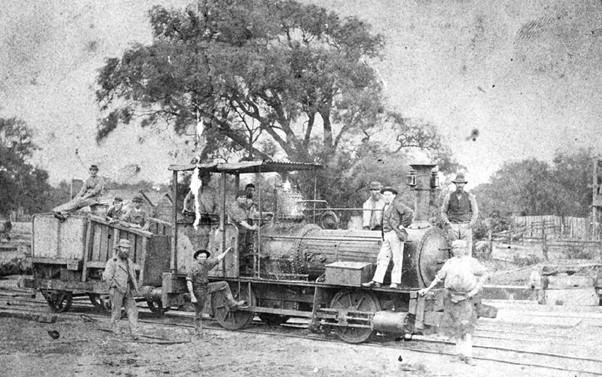Ballaarat Engine
The Ballaarat is a unique piece of heritage – it’s the oldest Australian built locomotive still in existence and the first engine that operated in Western Australia. 
It has great cultural and social value and has earned a spot in the hearts of many within the community. In contemporary history, the Ballaarat is fondly remembered by many locals as a place to clamber and play in Victoria Square at the entry to Busselton.
Early History
Assembled in 1871 in Ballarat, Victoria, the engine was transported by ship to Wonnerup where it operated for the Western Australian Timber Company, making it the first locomotive in Western Australia. It worked some 30km into the forest from the Lockville Jetty through to Maryvale. It had several modifications due to sparks and embers that flew from the funnel and were responsible for several forest fires, as well as setting alight the timber logs it was hauling.
However by 1877, the jetty was in poor condition and in 1887 the mill had closed due to financial difficulties. This is when the Ballaarat’s rich history starts to get interesting.
Around the early 1900’s, it was stored in a shed at Lockville, which subsequently caught fire and the timber lagging was probably burnt off during this time. It was left there in a paddock to deteriorate, although sometimes also used as prop for family photos and for children to climb.
Mr Percy Reynolds, became the owner of the property the engine was located on, he offered the engine to the Shire of Busselton, who at his recommendation, offered it to the WA Museum and then the Western Australian Government Railways (WAGR). In 1925, the engine was moved by WAGR to their Midland Workshops for refitting. However, due to the costs involved, the works were deferred and the Ballaarat was left in a railway yard. Fortunately in 1929, it was partially repaired for a Centenary parade through Perth at which point it was probably painted in the incorrect WAGR colours of red and black.
Five years later in 1934, the community requested the Busselton Municipal Council seek the return of the engine and after much debate, it was relocated and installed in Victoria Square, Busselton in 1937. 
Much like the iconic Busselton Jetty the people of Busselton have loved their engine. It is unique and the oldest surviving example of a steam locomotive built in Australia, one of only three of its type left in the world, and the only one existing in Australia (Railway Heritage Survey 1994).
When it again began to show signs of deterioration and vandalism, it was covered and then fenced off. Locals began to approach the then Shire to do something about the ongoing vandalism of their beloved engine.
Recent History
In late 2010 the Shire commissioned a Conservation Report by the WA Museum and the following year a Significance Assessment by Rail Heritage Consultant Philippa Rogers. A grant of $16,000 was received from Lotterywest and at the request of Councillors, City Officers negotiated with a local business to undertake works for the preservation as well as supervision of volunteers during work on the engine. A Rail Heritage Consultant was engaged to make regular inspections of the work as part of the grant conditions. These were valuable in ensuring not too much of the original fabric of the engine was removed or replaced.
The engine was moved to South West Machining Centre in August 2012 and the restoration commenced immediately. The engine was completely disassembled with rusted parts brushed by hand and sometimes soaked in molasses. The bigger parts of the engine were sandblasted, and an undercoat and professional top coat were applied locally. Over 550 volunteer hours by a hardy and diligent group of people have been recorded with many resources supplied by local businesses to restore the Ballaarat.
It was installed at the Railway House on the Busselton Foreshore whilst the construction continued around it – the building opened in March 2017. Railway House itself is a renovated railway station with a rich history of its own, before becoming the premises of the Busselton Visitor Centre. The Ballaarat Room houses an interpretive exhibition of the timber industry which underpinned the economy of the region, as well as a display of donated artefacts and a history ‘walk.’
In 2021, the engine reached its 150th anniversary, and to celebrate, the community was invited to share memories and photos of their interactions around the engine. These stories came from across the nation, and even overseas! Further interpretation was developed that consisted of panels with the memories and images from people, and a touch screen for an interactive experience was installed with historical information and timeline photography. A commemorative envelope was printed by Australia Post. Community activities included a walk along the old Ballaarat Track that tied in with a celebration by Rail Heritage WA at Wonnerup House, also celebrating 150 years of rail history. There was a colouring in competition for young people and the opportunity to sit on the Ballaarat engine for photographs! A limited amount of merchandise was also created. 
In 2022, the City was awarded a grant of $18,000 from Lotterywest to develop an augmented reality storyline. This new technology allows people from anywhere in the world (with internet access) to view the engine in their space. It has information about the parts of the engine via popups, and has recorded stories of a variety of social commentary of the times. These are taken from articles about the engine’s operations in the 1870’s. Also included are photos of the engine throughout its lifetime.
To interact with the 3D model, click on the link below and following the instructions:
- Click or tap and drag the engine around to look
- Mouse scroll or wheel, or pinch to zoom in and out
Ballaarat Engine 3D Model
The Busselton Visitor Centre is open daily from 9am-5pm.